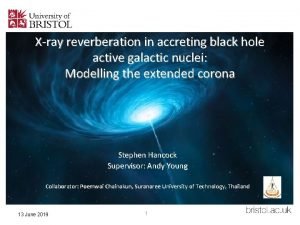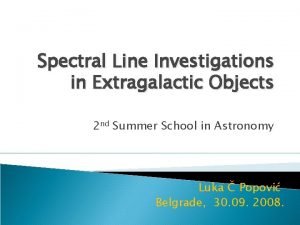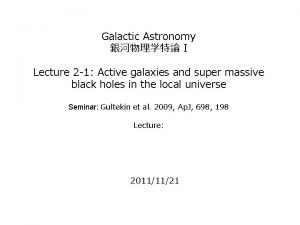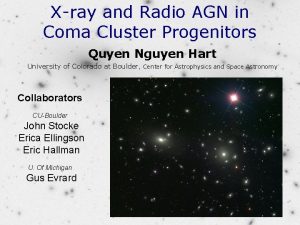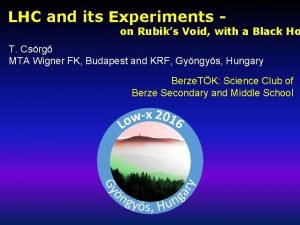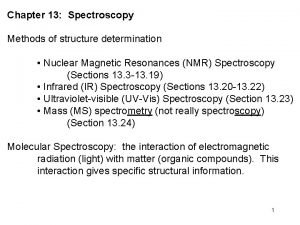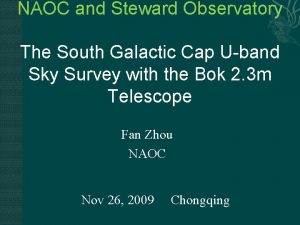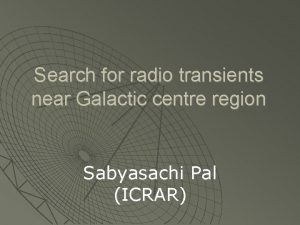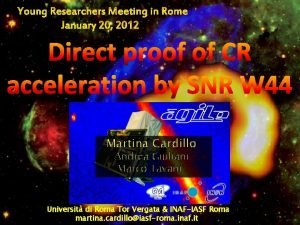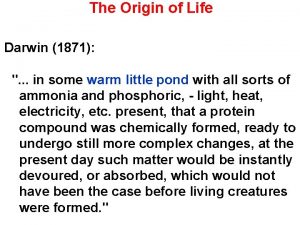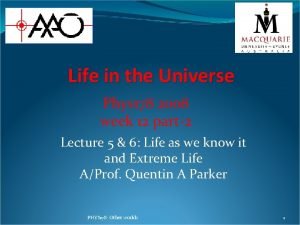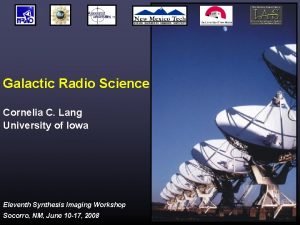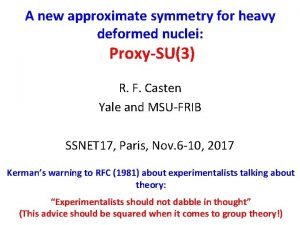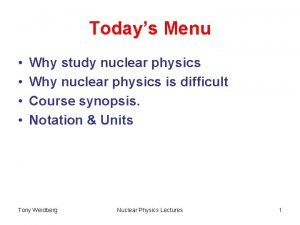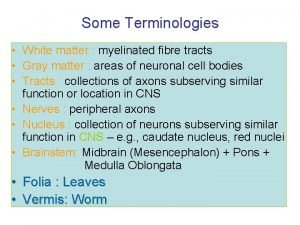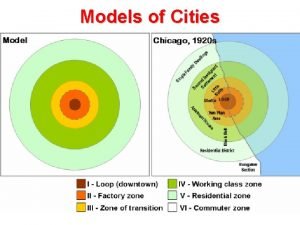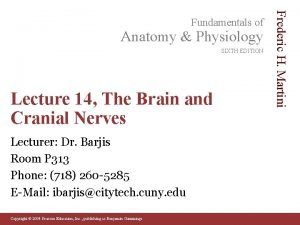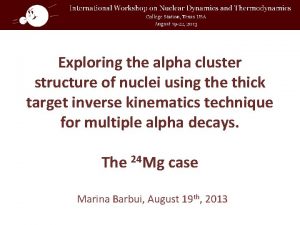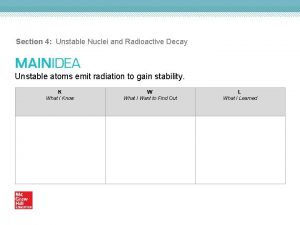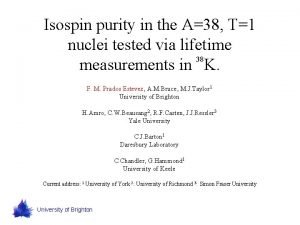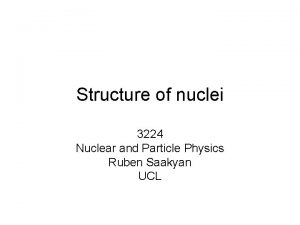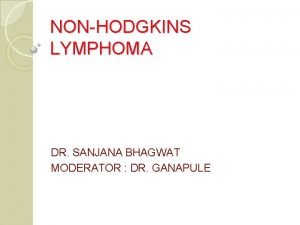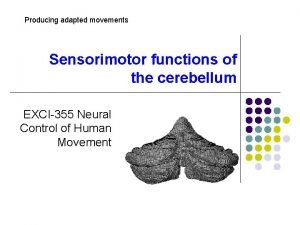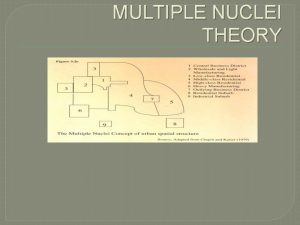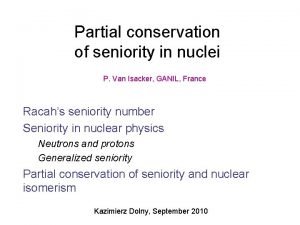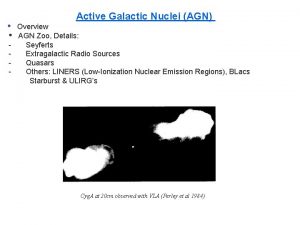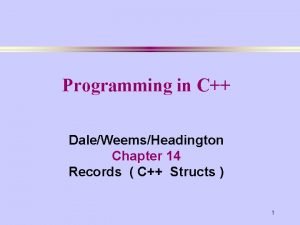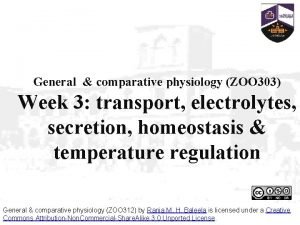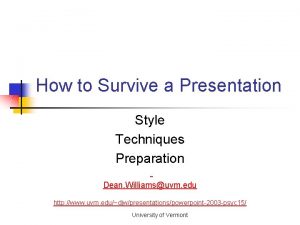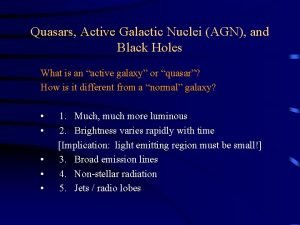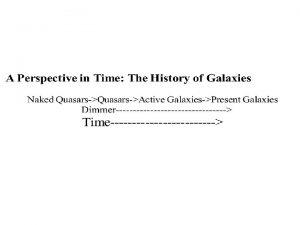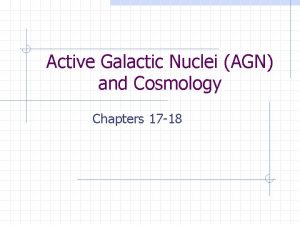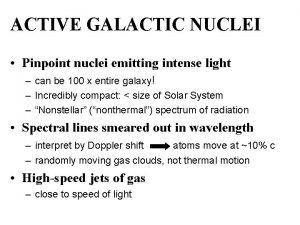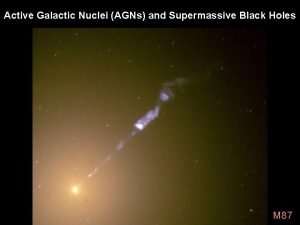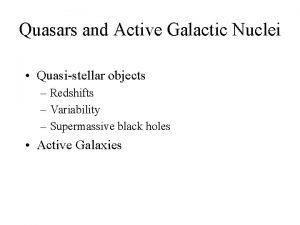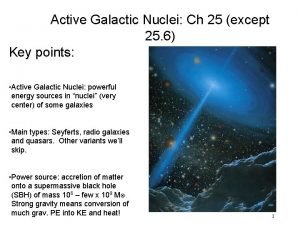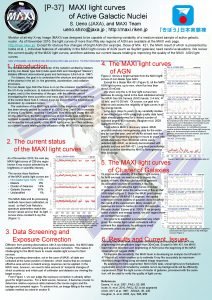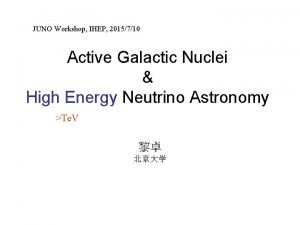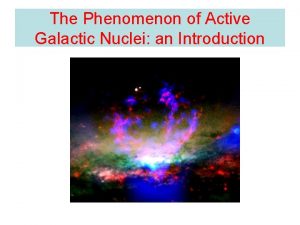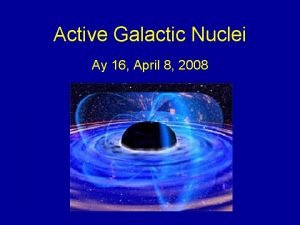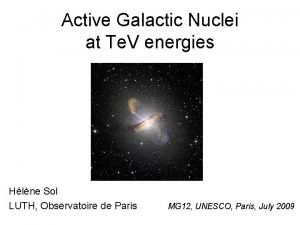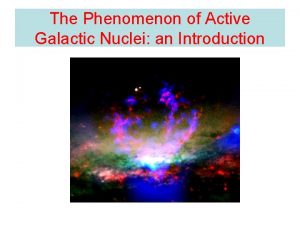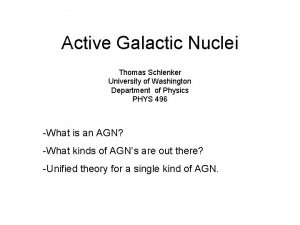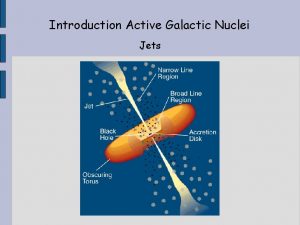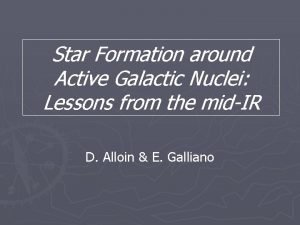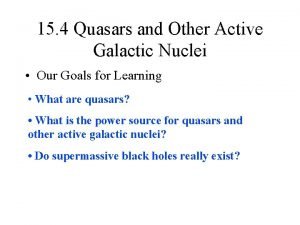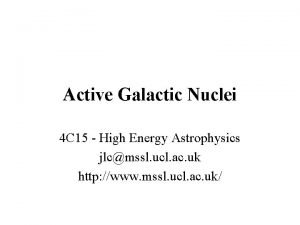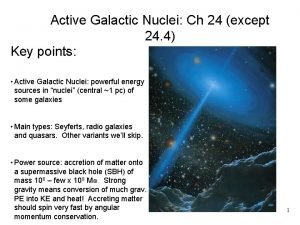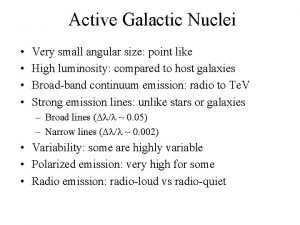Active Galactic Nuclei AGN Overview AGN Zoo Details













































































































- Slides: 109

• • - Active Galactic Nuclei (AGN) Overview AGN Zoo, Details: Seyferts Extragalactic Radio Sources Quasars Others: LINERS (Low-Ionization Nuclear Emission Regions), BLacs Starburst & ULIRG’s Cyg. A at 20 cm observed with VLA (Perley et al 1984)

Typical characteristics of active galaxies • • • They have high luminosities: up to 10 or 10’ 000 times greater than the 1037 W characteristic of a fairly bright MW-like galaxy (LAGN ~ 1042 – 1048 erg/sec; L* ~ 1042 erg/s) Their energy emission is mostly nonstellar it cannot be explained as the combined radiation of even trillions of stars; it is an additional energy source to the normal BB radiation of galaxies stellar, blackbody radiation Continuum emission: -Flat spectrum from IR → X-ray (v Fv ~ const. ) -Radio Power 10 -100 times larger -but also X-ray emission 103 – 104 times normal non-stellar radiation

Some spectral energy distributions (SED) of a variety of galaxies M 86: galaxy “normal” M 87: radiogalaxy NGC 1275: radiogalaxy and Seyfert Arp 220: galaxy “starburst”

• Their energy output can be highly variable (particularly Seyferts, BL Lac and Quasars) implying that it is emitted from a small central nucleus - Optical flux changes occur on timescales of days or months to years (Cause of variability? – instabilities in accretion disk, SN or starbursts, microlensing…. . ) Quasar light curve ~25 years Seyfert light curve over ~11 months Seyfert luminosity varies significantly in less than a year. This implies an emitting source less than 1 ly across - tiny! BL Lac even in the order of days!!! Variability occurs at most wavelengths - X-rays through radio

• They often exhibit jets and other signs of explosive activity Example: M 87 (central elliptical galaxy of Virgo cluster) long optical exposure (halo) short optical exposure of core only & jet) both images (left and right) on same scale!! (jet already noted by Curtis in 1918) somewhat expanded scale compared to optical images (roughly the same scale as radio image). Radio image of its jet (VLA, 6 cm) Near-infrared image of the jet (HST) Red dot left marks the nucleus of M 87; the red and yellow blob corresponds to optical "knot" in jet.

M 87 in radio continuum from the halo to the nucleus - “halo”: 12’ x 16’ - optical jet : 20” - nucleas : < 1 mas (0. 001”) 0. 08 pc ~17000 AU

• Their optical spectra may show broad emission lines, indicative of rapid internal motion within the energy-producing region. - Broad lines: 1000 km/s -10 000 km/s (Broad Line Region BLR) - Narrow lines: < 100 km/s (Narrow Line Regions NLR) Definition of subclasses Seyfert 1: Broad + narrow lines Seyfert 2: Narrow lines only

Source of energy production at the center of galaxies: Energy released by gas falling onto a central black hole A compact central source provides a very intense gravitational field. For active galaxies, the black hole has MBH = 106 - 109 Msun Infalling gas – because it will have some angular momentum - will form an accretion disk around BH Viscosity causes the gas to spiral inward; friction heats it to extremely high temperatures; emission from the accretion disk at different radii (T >104 K) accounts for optical through soft X-ray continuum. Magnetic fields are pulled inward with the flow of the hot ionized gas; close to BH, field may be strong enough to channel twin jets of relativistic plasma out along spin axis – they are close to speed of light.

Frequency and density Type Luminous spiral Seyfert galaxies Radio galaxies QSO’s (w/o radio emission) QSO’s (with radio emission) N (in 106/Mpc-3) 107 105 103 102 1 AGN were more common in the past (plot for quasars) Frequency: 2. 5 -10% of galaxies have AGN (now); >20% at z~2 Density : 120 Gpc-3 (now) ; 10 4 -5 Gpc-3 (z~2) [bright galaxies: ~106]

From Galaxies in the Universe, S&G, 2 nd edition

What’s the connection? – Evolution Black Holes form in the centers of young galaxies; “shine” as Active Galaxies (Quasars); With plenty of fuel available early on, the galaxy light is dominated by emission of the BH until the fuel (infalling gas) is used up. Most Quasars are now gone, but the BH remains. As small galaxies merge to form larger ones, BH may form at the nucleus. Additional mergers and depletion of fuel may result in powerful radio galaxies or Seyfert galaxies. Further fuel depletion results in a normal galaxies (E or S) with a dormant BH at the nucleus

Seyferts • • First noted by Fath at Lick Observatory in 1908 who was taking spectra of the nuclei of “spiral nebulae” and noted that NGC 1068 had strong emission lines. Slipher obtained a higher quality spectrum at Lowell in 1917, noted the lines were similar to planetary nebulae. In 1926, Hubble noted 3 galaxies with strong emission lines: NGC 1068, NGC 4051, NGC 4151 In 1943, Carl Seyfert recognized that there was a class of galaxies (now known as Seyfert galaxies), with strong, broad high-ionization emission lines and bright nuclei Seyfert nuclei are found in spiral galaxies. Seyferts have only moderate radio emission (~1040 erg/s) but strong xray emission (> 1042 erg/s). Seyfert 1 (permitted recombination lines are broader than forbidden lines), Seyfert 2 (both permitted and forbidden lines are narrow, < 1000 km/s). ~10% of Sa and Sb’s are Seyferts – does a galaxy spend 10% of its life as a Seyfert or are 10% of spirals Seyferts?

Forbidden & Permitted Lines? • • A forbidden transition is when the electron of an ion or atom is in a metastable state; it would take a “long” time to spontaneously decay to a lower state and emit a photon. Under normal circumstances (densities), the atom or ion would have collided with another ion or atom, losing the electron. In astrophysical circumstances, densities are so low that collisions are too rare; the electron can decay. Emitted photons from the decaying electrons are observed as a forbidden line.

Forbidden lines are put in brackets

NGC 5548 Seyfert 1 NGC 3277 Normal

Nucleus 10000 brighter than MW nucleus Seyfert galaxies (and other AGN) - very bright unresolved nucleus (like faint quasar) nuclei have MB > -23 (arbitrary division between quasars and Seyferts) → strictly a spectroscopic definition!!! - showing intense emission line spectra - covering a wide ionization range - line widths of 500 -5000 km/s. NGC 4151 short exposure long exposure requires non-stellar ionizing medium (soft X-rays from nucleus – BH? ) - Two types distinguished first by Khachikian and Weedman 1974 Ap. J 192, 581). -Type 1 (e. g. NGC 4151): show narrow forbidden lines plus broad permitted (Balmer) lines that have very broad wings (like QSOs and BLRGs=broad-line radio galaxies); -Type 2 (e. g. NGC 1068): have only narrow lines (permitted and forbidden); - Intermediate objects (like Seyfert 1. 5, 1. 8, . . . ) exist, with distinct narrow and broad components in Balmer lines. - Both types have continuum radiation from nucleus: and which generally is quite flat (α ~ 1) from IR to X-ray, though generally weak in radio - Seyfert 1 nuclei overall are brighter than Seyfert 2 nuclei (and slightly steeper α ~ 1. 5)

Their optical spectra may show broad emission lines, indicative of rapid internal motion within the energy-producing region. - Broad lines: 1000 km/s -10 000 km/s (Broad Line Region BLR) - Narrow lines: < 100 km/s (Narrow Line Regions NLR) Definition of subclasses Seyfert 1: Broad + narrow lines Seyfert 2: Narrow lines only

→ The broad-line region (BLR) requires a massive central object, since the velocities are much higher than any normal galaxy escape velocity Recall NGC 4258 (Hernstein et al. 1999) in Section 4 on BH Most conclusive evidence of a BH (4 x 107 Msun within 0. 2 pc)

What can we learn from the intense (featureless continuum) radiation of the nuclei? Note: not only for Seyferts; this is valid for all AGN!!! Light in nucleus is very intense → exerts pressure on gas around it if radiation pressure is too strong: no gas falls onto nucleus, nucleus runs out of fuel, inconsistent with what we observe Determine limit on luminosity that it can sustain, i. e. balance between radiation pressure Seyfert nucleus ↔ inward gravity force grav. attraction due to mass of nucleus Assume: spherical symmetry & that gas near nucleus is fully ionized H (a) Calculate outward force due to Thompson scattering by electrons (protons can be ignored because effect is insignificant due to their larger mass) Definition of cross-section of each electron: Photons emitted by nucleus have luminosity L and momentum L / c, implying that an electron at distance r receives momentum: Electrons and protons are coupled (electrostatic force is too strong to separate them) so we have to compare the outward force exerted on electrons ‘and’ protons to inward pull of mass M of nucleus: Inward force > outward pressure

The Eddington Luminosity LEd: maximum radiative luminosity that a star can have and still remain in equilibrium, or the largest luminosity that still allows material to fall onto nucleus From previous equation it follows: So, the luminosity of the nucleus must be less than LEd : L < LEd Considering that the luminosities of Seyfert nuclei are of the order of a whole galaxy (1011 Lsun), this allows us to determine the minimum mass the nucleus must have to avoid blowing away all the gas around it: M > 107 Msun …. Comparable to the BH mass determined for NGC 4258 What can we learn from the emission lines? -Both broad and narrow lines are result of photo-ionization from the continuum radiation emitted by the nucleus - For objects that have shown rapid variability (~days) the BL seem to follow suit about 30 days later – which gives an indication of its size (of the order of 1 pc), also called the Broad Line Region (BLR) - Narrow lines react much later (months) so are believed to originate further out from the nucleus than the BLR, called the Narrow Line Region (NLR) (of the order of 50 -100 pc) - From a study of the lines present in both regions, it can be deduced that the temperature of the gas in both regions is of the order of 104 K

Further properties of BLR: - electron number density is of the order of 109 – 1010 cm-3 ; this is deduced from the fact that no forbidden lines are seen; the atoms and ions are de-exited by collisions before downward transitions occur - it is generally believed that BLR is not homogenous but clumpy, with the material producing the emission having a filling factor of ε = 0. 01 - probably consists of a flattened distribution of optically thick clouds - the width of the emission lines suggest that the clouds orbit a central SMBH e. g. taking 5000 km/s as the orbital velocity, and r = 1017 cm (0. 2 pc as for NGC 4248) gives: consistent with previous minimum mass estimate based on Eddington limit Further properties of NLR: - electron number density is of the order of 104 cm-3 (comparable to PN and dense HII regions); both permitted and forbidden lines are seen, but only narrow lines, more mass in NLR than BLR. - it is also clumpy - believed to be composed of a more or less spherical distribution of clouds (like clumpy HII region); slow movements

Markania n 817 Hubble Space Telescope WFC 3

NGC 4151 -- Seyfert 1



NGC 1068

NGC 1068 – optical & x-ray X-Ray Optical

• • • Radio Galaxies Advances in radio astronomy in the 1950 s led to the discovery of radio galaxies including Cygnus A with a redshift of z=0. 057 Many others identified in large area radio surveys such as the third Cambridge (3 C, 1959), fourth Cambridge (4 C, 1965), and PKS (Parkes, 1969) surveys Emission-line spectra of radio galaxies similar to Seyfert galaxies – – • • • Broad line radio galaxies (BLRG) ~ Seyfert 1 Narrow line radio galaxies (NLRG) ~ Seyfert 2 Radio galaxies are typically found in elliptical galaxies, with extended (100 kpc – 10 Mpc) jets Radio emission is nonthermal (synchrotron radiation) produced by energetic particles moving through magnetic fields (L>1042 erg/s) There are 2 classes based on jet morphology: – – Fanaroff-Riley Type I (FRI) – edge darkened radio jets, slower jet speeds, lower radio power, two sided jets Fanaroff-Riley Type II (FRII) – edge brightened radio jets, fast jet speeds ~0. 1 c, higher radio power, one sided jet or different luminosities

Radio Galaxies High resolution observations of radio galaxies often show highly extended emission. Best known case: Cygnus A Lobe Jet Nucleus Hotspot Emission is synchrotron radiation Physical extent can be large: typically several hundred kpc, though much smaller and larger examples exist

Radio Galaxies: - Normal stars and galaxies do not emit strongly in radio (optical luminosity of MW is over 1010 Lsun, whereas radio emission is only of the order 2500 Lsun) - Seyferts 100 -1000 times more luminous in radio than typical MW-like galaxy - Galaxies are called radio galaxies when radio emission exceeds ~108 Lsun (1034 W); most powerful radio galaxies and quasars radiate up to 1012 Lsun (1038 W) - Emission is highly polarized synchroton radiation Radio catalogs 3 C-catalog (Edge et al 1959) – 3 rd Cambridge catalog, covering northern sky at 117 MHz, discovering 471 radio sources brighter than 9 Jy 4 C catalog (Pilkington et al. 1967) – with 5000 sources 5 C …. deeper and in parts (1 -16 so far) for 408 MHz and 1407 MHz Over time all were unambiguously identified with optical sources -some Galactic sources (SN remnants) most are extragalactic in origin, with large fraction at high redshift (z > 0. 5) majority appear normal elliptical galaxies – generically called radio galaxies

Cygnus A – Radio Galaxy


Observationally define two classes of radio galaxy: • Fanaroff & Riley class I (FR-I) Separation between the points of peak intensity in the lobes is less than half the largest size of the source • Fanaroff & Riley class II (FR-II) Separation between the points of peak intensity in the lobes is more than half the largest size of the source FR I: 3 C 272. 1 FR II: 3 C 47

FR I: hot spots are separated by less than half the distance of RS (roughly on inner side) FRII: hot spots lie on outside of the system FR I - 3 C 449 FR II - 3 C 47 Also often referred to as: Extended Edge-Darkened Double Sources (FR I) Extended Edge-Brightened Doubles Sources (FR II)

Morphological classification also divides radio galaxies into low radio power and high radio power classes: • FR I: relatively low power sources • FR II: more powerful sources Break power is about 1032 erg s-1 Hz-1 sr-1 Different appearance probably reflects combination of power and environment… Outflows from AGN could play an important role in galaxy and / or cluster formation: • Provide energy source into ISM, intracluster medium • May be more important than the radiation, which can escape the galaxy or cluster more easily

Morphology of Radio Galaxies Interferometers resolve structure (see pretty picture of Cyg A on slide 8) - nuclear compact source, optically thick, prominent at high frequencies - 2 amorphous regions (radio lobes), optically thick, up to distances of Mpc’s away from nucleus, often connected by jet(s) emerging out of nucleus (as seen in high resolution images) → to fill the lobes nucleus must have been active for at least 10 -15 million years Low frequencies - lobe is prominent, nucleus weak High frequencies - nucleus prominent Approximation of radio spectrum: Lv ~ ν-α α … spectral index: 0. 5 < α < 1. 2 in lobes α~0 in core Within lobes, hotspots of ~ 1 kpc can be identified (note: about 10% of hotspots also emit synchroton radiation in optical and X-ray; see e. g. slide 4 of jet in M 87) Within a lobe, the SB usually peaks at a well-defined location. On the basis of the relative location of these hotspots, Fanaroff & Riley (1974) divided radio galaxies into 2 classes: FR I and FR II

FR I: FRII: P 1. 4 ~ < 10 24. 5 W Hz-1 P 1. 4 ~ > 10 24. 5 W Hz -1 → limit is extremely close to break in LF of radio galaxies For L > 1026 W /Hz the source almost always has a bright edge; suggests: most luminous sources are associated with most violent and recent ejections; edge-brightened galaxies: fractional flux in hot spots increases with luminosity M in R-band; from Ledlow & Owen 1996) FR I and II occupy distinct regions in LR / P 1. 4 plane: FR I: large R luminosities, small radio power, whereas FRII other triangle of LR / P 1. 4 plane Spectroscopic classification of radio galaxies (if lines are visible) NLRGs (Narrow line …): like Seyfert 2 s; FR I or II BLRGs (Broad line …): like Seyfert 1 s; FR II only

Morphology of jets • Observed on large-scale in extended diffuse emission, but also on smaller scales close to compact central source • Morphology of extended sources suggests: material ejected from nucleus of associated galaxy • Jets are therefore thought to mark path of followed by ejected material • A bit over 100 jets are identified. They are found in all types of radio sources, whatever the luminosity, size of morphology. Some found in Seyferts. The radio source associated with center of our Galaxy is similar to extragalactic jets. • Jets are strongly correlated with activity in galactic nuclei Symmetry, Shape and Size: Extended objects reveal remarkable symmetry (eg. Cyg A ) Jets, however, generally are strongly asymmetric in the immediate neighborhood of compact components; often show up on only one side. At greater distances (d > 1 kpc), the brightness distribution becomes more symmetric FRI: the jets appear more symmetric on average FRII: the jet is often detected on one side only, even at large scales

from Bridle & Perley 1984, ARv. A&A

49 cm 21 cm 2. 8 cm

Jets frequently have elongated shapes In sources with 2 tails, the jets are clearly curved (thus like diffuse emission strongly influenced by interaction with external medium Sometimes show ‘wiggle’ about the mean direction. Possibly due to interaction with neighboring galaxy: reflection of orbital motion In the sources where central source dominates, the jets are generally smaller: only the projected can be measured. Most likely the angle between LOS and jet direction is small. This might also explain why size and presence of strong compact component are correlated: the emission towards the observer can be enhanced if the emitting plasma is moving relativistically. Various knots in jets indicate regular fuelling of jets and lobes over long timescales. But also what has also been observed are actual changes in the structure of the jets on observable timescales with radio interferometry, hot spots which appear to move with time this has led to the detection of ‘so-called’ superluminal motion in various jets (3 c – 50 c), an effect now being explained purely on the basis of geometry:

FR II radio galaxies: most Radio “Light” emission comes from lobes Centaurus A 0. 8 M pc Visible Light The radio lobes span about 10 degrees on the sky! Lobes consist of material ejected from the nucleus.

Centaurus A • • Nearest Active Galaxy Giant Elliptical Emission Lobes in Radio Hot gas and jet in X-Ray.



HST


Radio Galaxies

NGC 6251 – Radio Galaxy

3 C 175 FRII

M 84 FRI

M 84 S 0


Optical Jet in M 87

Quasars • Some radio sources were not associated with galaxies, but with stellar-like sources on optical images • • • In 1963, Maarten Schmidt made the breakthrough that the spectrum of 3 C 273 had nebular emission lines at then unheard redshift of z=0. 158 Soon afterward, 3 C 48 was found to be at a redshift of z=0. 367 (thus began the race for the highest redshift quasar!) Quasars are very luminous – L~1013 -1015 L These objects are AGN whose nuclear light dominates so that we can’t distinguish the host galaxy These objects are known as quasistellar radio sources (quasars); there also quasistellar objects (QSO’s) identified via the spectra that are radio quiet Radio quiet QSO’s outnumber quasars by 10 -30 x, the term quasar is often used for both Quasars are variable over small time scales – hours to days! Current record for the highest redshift quasar ULAS J 1120+0641, is at z = 7. 1 (This number changes every year. ) Most distant object in the Universe at present it a Gamma-Ray Burst however (z=8. 4).

HST Observations: If we block out the light of luminous quasar, we can see evidence of an underlying host galaxy. Quasar hosts appear to be a mixed bag of galaxy types from disturbed galaxies to normal E’s and early type spirals. Characteristics: MB < -23, strong non-thermal continuum, broad permitted (~10’ 000 km/s) and narrow forbidden (~100 -1000 km/s) emission lines Two types: Radio quiet (RQQ): elliptical or spiral host galaxies Radio loud (RLQ): elliptical hosts, 5 -10% of all quasars Broad Absorption Lines (BAL) Quasars: normal quasars seen at a particular angle along the LOS of intervening, fast-moving material. - High-ionization (HIBAL): Lyα, N V, Si IV, C IV

PKS 1117 -248, z=6. 42 (record changes yearly)

ULAS J 1120+0641 z~7. 1

Why would the furthest quasar be important?


Radio loud quasar Radio quiet



Blazars BL Lac objects: - discovered in 1929 as variable stars (BL Lacertae, AP Librae). - virtually featureless continuous spectra with very weak (or absent) emission lines (and therefore very difficult to determine redshifts) - have occasionally been considered as bare QSO cores, with no surrounding emission-line regions (they are elliptical galaxies) - very compact radio sources (best candidates for Doppler-boosted radiation from relativistic jets directed toward us). - variability faster and higher amplitude than normal quasars and Seyferts - high polarization, emission lines have low equivalent width OVVs (Optically Violent Variables) – quasars with similar pattern of variability but with strong emission lines The 2 types together are often lumped together (BLAZARS), are always radio-loud; are most luminous objects in Universe (> 1014 Lsun) – but we see only little of it (jet directed to observer) Spectrum Light Curve

LINERs and ULIRGs - Starburst or AGN? What is a starburst? • May result from a galaxy collision/merger • Gas streams converge from different directions causing shocks which compress material and trigger star formation • Gas which loses enough angular momentum falls into the galaxy center ⇒ bar formation ⇒funnels more gas inward ⇒violent star formation near center of disk and further out Nuclear close-up (HST) of NGC 1808 starburst galaxy. Galaxy has barred-spiral morphology.

LINERs • Low-Ionization Nuclear Emission Region • Narrow low-excitation emission lines • Weak non-thermal continuum • Spiral host galaxies (80% found at centers of Sa, Sb galaxies, smaller proportions of Sc and also E galaxies) • Observed emission could be due to AGN or shocks/winds from a starburst • Some appear as unresolved compact sources in the UV • Some have radio sources: AGN or supernovae remnant? Used to be treated as distinct phenomenon, now regarded as low-luminosity tail of Seyferts ULIRG’s - Ultra Luminous IR Galaxies • Galaxies that emit most of their light in IR: LIR > 1012 Lsun • Few in local universe; most beyond z > 1 • Nearly all are undergoing mergers - forming E’s • IR light is likely a combination of dust reprocessed AGN emission and starbursts. • First detected in IRAS all-sky survey • Some AGN may manifest as ULIRGs during different stages of evolution. Nicmos Near-IR Image of IRAS selected ULIRG

Spectra of each class


What does it all mean? • Variability on short time scales implies a small area: – R=cΔt ~ 7 -10 AU !! (for timescale variability on the order of hours) • • • Highly luminous! Probably powered by a black hole!! Schwarzschild radius is the radius where the “escape velocity” equals the speed of light around a black hole of mass M: –R • • Sch=2 GM/c 2 Continuum emission powered by gas falling onto central black hole, losing potential energy and radiating Since gas has angular momentum it forms an accretion disk

Their highly variable (particularly Seyferts, BL Lac’s and Quasars) implying that it is emitted from a small central nucleus Why does rapid variability indicate small physical size of the emitting object? Consider an object like the Sun. Any instantaneous flash would appear “smeared out” in time by Δt = RSun /c =700000 km/300000 km/s = 2. 3 s RSun OBSERVER Time Delay allow determination of size of object: (relativistic as most AGN are at high z) BL Lac and Quasars can have variabilities of the order of hours to days (Seyfert’s weeks to months). Note 1 hr ↔ 7. 2 AU; AGN can produce energies of hundreds of MW’s within size of solar system

AGN Classifications • • Seyfert galaxies (Type I and II) Quasars BL Lacs or Optically Violent Variables (OVV) Radio galaxies (in `Broad line’ and `Narrow line’ variants) All of these have Black Holes powering the central source. How different are these objects?

Unified model (scheme? paradigm? ) • Consists of an accretion disk around a supermassive black hole • • Gas clouds in surrounding galaxy are ionized by this central engine Clouds closest to the central engine are dense and have high velocities (otherwise they would fall in!). So emission lines from this region are broad (~2000 km/s) – the broad line region (BLR) Clouds farther away from the central engine have a lower density and lower velocities. Line emission is narrow (5001000 km/s) – the narrow line region (NLR) Dust torus surrounds the central engine and BLR in the same plane as the accretion disk. The orientation of the dust torus relative to the line of sight affects the appearance of the AGN.

Unified Scheme

Unified Scheme Seyfert 1 Broad-line Radio Galaxy Jet Narrow-line region Seyfert 2 broad-lines Torus Narrow-line Radio Galaxy Blazars Black hole and accretion disk

Putting it all together : for Seyferts and all other AGN including Quasars Broad Emission line region photoionized by 2 size is continuum emission; ~few light-days to months; densities > 109 /cm 3; stratified (higher-ionization lines from smaller radii) Obscuring Torus of dust is believed to form around perimeter of accretion disk Narrow Emission line 1 region Seyfert also photoionized; size is ~10 to 1000 pc; densities ~103 - 106 /cm 3; complex morphology

Unified Theory of Active Galaxies 2 Observer is looking at blackhole “edge-on” through the surrounding dusty torus does not see broad emission lines produced by gas near BH Seyfert 1 Observer is looking into the center of the accretion disk, viewing motions of gas near blackhole - sees broad emission lines Jet pointing towards observer, small radii, deep in core of AGN, rapid variability

Image from “Chandra Image Gallery” Blazar Grand Unification Theory Quasar Seyfert 1 Radio galaxy Seyfert 2 (Urry 2004) le w Vie in ng a g

Viewing angle and accretion LINER Obscured by torus Unobscure d by torus Directly down the jet Seyfert 2 NLRG Type 2 Quasar Seyfert 1 BLRG Type 1 Quasar Blazars Accretion Rate

orientation and classification Face-on Edge-on Radio Quiet Seyfert 1 Seyfert 2 QSO Radio Loud BL Lac FR I BLRG NLRG Quasar? OVV FR II

Unified Model Different wavelength light comes from different areas of the “central engine”: – – X-ray + UV from innermost parts of disk and jet Radio from particles accelerated to relativistic energies in the jet (synchrotron radiation) – Visible light (continuum) from farther out in disk or jet – Visible light (emission lines) from BLR and NLR clouds – Infrared from radiation from surrounding dust grains, either in clouds or in torus



An obscuring accretion torus around AGN Antonucci & Miller (1985) observed NGC 1068 (a Seyfert 2) in polarized light detected a Seyfert 1 spectrum with broad emission lines → Later on more such cases were observed Implication: within Seyfert 2 there is a Seyfert 1 nucleus hidden from view of observer; diminished Seyfert 1 spectrum comes from indirect light reflected by ISM (reflected light is usually polarized) Seyfert 2 galaxies probably all have a hidden BLR, which can only be seen by the reflection of its light in a layer of dust and gas → assumption of the existence of a dusty doughnut-shaped torus around AGN General idea now is that Seyfert 1 and Seyfert 2 are the same, its characteristic features depend on LOS of observer: Seyfert 1: looking down on the disk - seeing bright continuum emitting nucleus, BLR and NLR Seyfert 2: viewing close to edge of the disk - seeing fainter nucleus, no BLR, but emission from larger and spherical NLR Additional evidence in support of this picture: X-ray emission. Low energy X-ray are absorbed by dust torus; Seyfert 2 galaxies show larger proportion of hard X-ray compared to low X-ray than Seyfert 1 galaxies.

Why do we still see the continuum in Seyfert 2 galaxies? Scattered continuum Continuum radiation comes from the disk at smaller radii than the broad lines - why doesn’t the torus block that too? Assume that a scattering medium (e. g. free electrons) scatters some of this radiation into our line of sight…


Repeat: Jets frequently have elongated shapes In sources with 2 tails, the jets are clearly curved (thus like diffuse emission strongly influenced by interaction with external medium Sometimes show ‘wiggle’ about the mean direction. Possibly due to interaction with neighboring galaxy: reflection of orbital motion In the sources where central source dominates, the jets are generally smaller: only the projected can be measured. Most likely the angle between LOS and jet direction is small. This might also explain why size and presence of strong compact component are correlated: the emission towards the observer can be enhanced if the emitting plasma is moving relativistically. Various knots in jets indicate regular fuelling of jets and lobes over long timescales. But also what has also been observed are actual changes in the structure of the jets on observable timescales with radio interferometry, hot spots which appear to move with time this has led to the detection of ‘so-called’ superluminal motion in various jets (3 c – 50 c), an effect now being explained purely on the basis of geometry:

Apparent superluminal motion On small scales, jets near the nucleus often show hotspots or `knots’ which can be seen to move with time - e. g. M 87: Not certain that the motion of these knots reflects physical speed of the jet. But if it does, inferred velocity in the plane of the sky exceeds the speed of light. Phenomenon of apparent superluminal motion. Apparent velocity v ~ 6 c

Superluminal motion Explanation: Observer Blob is emitted and wanders towards C at an angle of θ with respect to line of sight to observer at A The blob passes point B at time t = 0, and point C at Δt later The emission at C is radiated Δt later compared to B, but distance towards observer is v Δt cosθ shorter and interval between arrival is only The distance traveled across the sky: V Δt sin θ Apparent transverse speed is: Apparent velocity v ~ 6 c (if motion of knots reflects physical speed) Thus if V → c and angle θ is small. Motion can appear faster than speed of light

Apparent v~4 c!!

Histogram of observed v/c in 33 jets

Superluminal Motion The blobs are actually moving towards us at an angle φ measured from the line of sight. Photon emitted along the line of sight at time t=0, travels a distance d to us, taking a time t 1 to arrive: t 1 = d/c A second photon is emitted at a time Δt later, when The blob is a distance d – v Δt cosφ away from us. The second photon arrives at t 2 = Δt + (d - v Δt cosφ)/c The observed difference in the time of arrival from photon 1 & 2 is: Δtobs = t 2 - t 1 = Δt (1 – vcosφ/c) < Δt

Superluminal Motion The apparent transverse velocity is vapp = v Δt sinφ / Δtobs = v sinφ / (1 – v cos φ/c) As v approaches c, vapp can appear > than c! Superluminal motion, typically 5 -10 c! Let γ = 1/(1 - v 2/c 2)1/2, this is the Lorentz factor. Then: vapp ≤ γ v (the maximum observed velocity) which occurs when cos φ = v/c. We will only observe superluminal motion when the jets are pointed within an angle of 1/γ towards the line of sight, but this light will be beamed and brightened.

Relativisitic Beaming To a stationary observer, the “clocks” On the blob appear to run slow by a factor of γ , from before: Δtobs = Δt (1 – vcosφ/c) Δtobs = Δte γ (1 – vcosφ/c) So the observed frequency of the light is ν obs = ν e[γ (1 – vcosφ/c)]-1 When γ >>1, all the light is focused into a narrow cone of sinφ=1/γ ~ φ, and compressed in time by Δtobs = Δte /2 γ. Thus the light will be brightened by a factor of 1/(2γ )2 The beaming effect explains why we usually only see one relativistic jet; the one being beamed towards us.

Explanation of apparent superluminal motion Explain apparent superluminal motion as an optical illusion caused by the finite speed of light. Consider a knot in the jet moving almost directly towards us at high speed: C A vδ t. sinθ Δφ vδ t θ D vδ t. cosθ B

Observer does not know v or θ. Observer measures: • Time difference between blob being ejected and reaching position C • Angular separation between B and C. Assuming that the distance D to the source is known, this gives the projected separation Angular separation : vδ tsinθ Δφ = D Time difference as seen by the observer Let blob be† emitted at time t = 0 Observer sees blob being emitted at time t 1: t 1 = D+ vδ tcosθ c :

Observer sees blob reach position C at time t 2: D t 2 =δ t + c D Time difference is: Δt = t 2 − t 1 =δ t + =δ t(1−β cosθ ) D+ vδ tcosθ − c c …where we have defined β = v / c Observer infers a transverse velocity: βT ≡ v. T c = 1 c x DΔφ Δt = vsinθ = c(1−β cosθ ) βsinθ 1−β cosθ For β close to 1, and θ small, can clearly get an apparent transverse velocity v. T > c (i. e. β T > 1). e. g. β = 0. 99, θ = 10 degrees gives β T= 6. 9.

Apparent transverse velocity as a function of angle θ for different values of the true velocity: β = 0. 5, 0. 95, 0. 99 Note : βT = v(obs) / c β = v/c first occurrence (source) Apparent superluminal motion If real v > 0. 9 c, apparent superluminal motion will be seen in majority of sources (assuming random orientations).

True velocity must exceed a critical value for superluminal motion to be observed (irrespective of orientation). First find angle at which β T is maximized: ∂β T = β cosθ − β 2 sin 2θ =0 ∂θ 1− β cosθ (1−β cosθ )2 Solving this equation for θ = θ max gives: β max T = θ max = cos-1β β 1−β 2 Set left hand side equal to one and solve for β: 1 -β 2 min = β 2 min β min = 2 2 = 0. 707�

Conclude: motion of jet does not need to be highly relativistic to observe superluminal motion Actual properties of AGN jets are mostly unknown: • Velocity • Composition (e-p or e--e+) Note: apparent superluminal motion is really a geometric effect - we have not appealed to any aspects of special relativity except for the restriction v < c.

Fuelling requirements: • • Radiation force (scattering off electrons) Frad = (L/4πr 2)(σ T/c) Gravitational force Fgrav=GM(mp+me)/r 2 ~ GMmp/r 2 Setting the two forces equal: (L/4πr 2)(σ T/c) = GMmp/r 2 We can solve this for L, this is the Eddington limit on the luminosity that can be created by the BH and still allow mass to fall in: LEdd= 4πGM mpc/σ T ~ 1. 3 x 1038 (M/M ) ergs/s

Fuelling requirements: • Similarly, we can solve this for mass and derive the minimum mass of a BH causing an observed luminosity: Medd=(L/4π)(σ T /Gcmp) ~ 8 x 105 L 44 M (L 44 luminosity in units of 1044 erg/s) • For quasars, L~1046 erg/s, so M ~ few x 108 M We can also define the Eddington accretion rate d. Medd/dt required to sustain the Eddington luminosity d. Medd/dt = LEdd//ηc 2 where η = efficiency factor ~0. 1 d. Medd/dt ~ 2. 2 M 8 /M per year (M 8 is mass in units of 108 M )

Quasar host galaxies: • Quasar host galaxies: – – • • Many are interacting – does interactions trigger AGN activity? Promote fuelling gas into centres? Note not all galaxies with SMBH are AGN (even the Milky Way) Quasars were much (~1000 x) more numerous at z~3 than today – – • • One can image quasar hosts with HST Is an AGN a requirement for galaxy formation? Does every galaxy have a SMBH? (Remember -- lots have been discovered in nearby ellipticals and bulges!) More interactions in the past? Quasars were also much more luminous in the past There is probably some combination of luminosity and density




Many (all? ) ellipticals (& bulges) have black holeseven compact ones like M 32! Can measure BH masses for galaxies without central disks via their velocity dispersion

Black holes • • Currently there are observations of at least 40 BH masses in nearby ellipticals and spiral bulges There is a strong correlation between black hole mass and galaxy luminosity and velocity dispersion

Black hole mass vs. galaxy luminosity & velocity dispersion From Kormendy (2003) review

 Active galactic nuclei
Active galactic nuclei Active galactic nuclei
Active galactic nuclei Active galactic nuclei
Active galactic nuclei Hmong language
Hmong language Agn
Agn Ncp for agn
Ncp for agn Difference between agn and nephrotic syndrome
Difference between agn and nephrotic syndrome Agn rubik's cube
Agn rubik's cube Nmr active and inactive nuclei
Nmr active and inactive nuclei Signal words
Signal words Word signals
Word signals Galactic cap review
Galactic cap review Galactic address
Galactic address Galactic centre radio transients
Galactic centre radio transients Martina cardillo
Martina cardillo City model
City model Galactic habitable zone
Galactic habitable zone Galactic habitable zone
Galactic habitable zone Swcombine
Swcombine Galactic phonics ure
Galactic phonics ure Galactic
Galactic Galactic city model
Galactic city model Galactic city model
Galactic city model Boolean operators
Boolean operators Primary active transport and secondary active transport
Primary active transport and secondary active transport Primary active transport vs secondary active transport
Primary active transport vs secondary active transport Strengths of the multiple nuclei model
Strengths of the multiple nuclei model Nuclei proxy
Nuclei proxy Diencephalon
Diencephalon Primo motoneurone
Primo motoneurone Harris and ullman multiple nuclei model
Harris and ullman multiple nuclei model Mirror nuclei examples
Mirror nuclei examples Pros and cons of multiple nuclei model
Pros and cons of multiple nuclei model Nucleus ventralis posterolateralis
Nucleus ventralis posterolateralis Nuclei of thalamus
Nuclei of thalamus Thalamus boundaries
Thalamus boundaries Orphan annie eye nuclei
Orphan annie eye nuclei Harris and ullman multiple nuclei model
Harris and ullman multiple nuclei model Cortul cerebelului
Cortul cerebelului Cbd model
Cbd model Multiple nuclei model definition ap human geography
Multiple nuclei model definition ap human geography Telencephalon
Telencephalon Harris and ullman multiple nuclei model example
Harris and ullman multiple nuclei model example Nuclei of cerebrum
Nuclei of cerebrum Nuclei narrativi promessi sposi
Nuclei narrativi promessi sposi Atn
Atn Nuclei
Nuclei Nuclei cerebelli
Nuclei cerebelli Multiple nuclei model
Multiple nuclei model How unstable atoms gain stability
How unstable atoms gain stability Raphe nuclei
Raphe nuclei High nc ratio
High nc ratio Via indiretta gangli della base
Via indiretta gangli della base Comment démarrer un nuclei
Comment démarrer un nuclei Nuclei
Nuclei Multiple nuclei model
Multiple nuclei model Suburban sprawl ap human geography
Suburban sprawl ap human geography Multiple nuclei model
Multiple nuclei model Multiple nuclei model
Multiple nuclei model Sulcus anterolateralis medulla oblongata
Sulcus anterolateralis medulla oblongata Aree associative
Aree associative Magic number in nuclear physics
Magic number in nuclear physics Multiple nuclei model
Multiple nuclei model Brain diencephalon
Brain diencephalon Kernsäulen hirnstamm
Kernsäulen hirnstamm Follicular nonhodgkins lymphoma
Follicular nonhodgkins lymphoma Geniculate nucleus of the thalamus
Geniculate nucleus of the thalamus Cerebellar outputs
Cerebellar outputs Via indiretta gangli della base
Via indiretta gangli della base Nuclei di cure primarie
Nuclei di cure primarie Nuc olivaris inferior
Nuc olivaris inferior Nuclei cocleari
Nuclei cocleari Preoptic area hypothalamus
Preoptic area hypothalamus Nucleii cohleari
Nucleii cohleari Limbic system nuclei
Limbic system nuclei Harris ullman model
Harris ullman model Nutmeg liver
Nutmeg liver Atomic nuclei
Atomic nuclei Function of spine
Function of spine Concentric sector and multiple nuclei model
Concentric sector and multiple nuclei model The distinct threadlike structures that contain the genetic
The distinct threadlike structures that contain the genetic Harris and ullman theory
Harris and ullman theory мозъчен ствол
мозъчен ствол Nuclei
Nuclei Cranial vii
Cranial vii Multiple nuclei model definition geography
Multiple nuclei model definition geography Art of zoo
Art of zoo Edenborough zoo
Edenborough zoo Deep underwater
Deep underwater Pep zoo zip
Pep zoo zip When did london zoo open
When did london zoo open Taipei zoo opening hours
Taipei zoo opening hours A cheerful old bear at the zoo
A cheerful old bear at the zoo Zoo 78
Zoo 78 Oop.gov.tw
Oop.gov.tw In den zoo gehen
In den zoo gehen Fort wayne zoo admission
Fort wayne zoo admission Klner zoo
Klner zoo Un deux trois claque tes doigts
Un deux trois claque tes doigts Zoo record keeping systems
Zoo record keeping systems Decathlon znaczniki
Decathlon znaczniki Miller zoo emission
Miller zoo emission Zoo çoğul hali
Zoo çoğul hali Atof zoo
Atof zoo The professional development group
The professional development group London zoo
London zoo Couplet triplet quatrain quintet
Couplet triplet quatrain quintet Sir stamford raffles contributions
Sir stamford raffles contributions Zoo 303
Zoo 303 Uvm zoo files
Uvm zoo files
